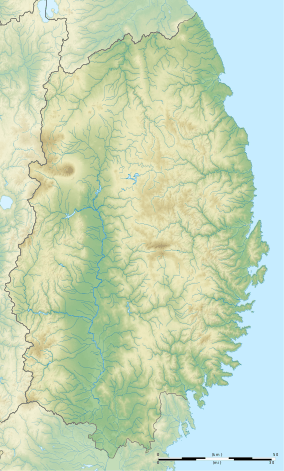Ōhora Shell Mound
| 大洞貝塚 | |
 Location in Japan  Ōhora Shell Mound (Japan) | |
| Location | Ōfunato, Iwate, Japan |
|---|---|
| Region | Tōhoku region |
| Coordinates | 39°04′01″N 141°44′40″E / 39.06694°N 141.74444°E |
| Altitude | 31 m (102 ft) |
| Type | shell midden, settelement |
| Area | 20,000 sq.m. |
| History | |
| Periods | late Jōmon period |
| Site notes | |
| Ownership | National Historic Site |
| Public access | Yes |
Ōhora Shell Midden (大洞貝塚 Ōhora kaizuka) is a Jōmon period archaeological site consisting of a shell midden and the remains of an adjacent settlement located in what is now the city of Ōfunato, Iwate Prefecture in the Tōhoku region of northern Japan. It is protected by the central government as a National Historic Site.[1]
The rocky rias coast of Iwate Prefecture was densely settled from the early through late Jōmon period, and the locations of such coastal settlements are often marked by shell middens containing shellfish, fish, animal and whale bones and human-produced artifacts, including earthenware shards, fishing hooks, etc. In particular, the deeply indented Ōfunato Bay area was a rich fishing ground and is the location of 16 known Jōmon-period shell middens, a number of which have been designated National Historic Sites.
The Ōhora Shell Midden dates from the late Jōmon period, and is located at an elevation of 31 meters above the present sea level, on a small peninsula on the east side of the bay. The midden consists of two separate groups of mounds, which were first excavated in 1925 by the Tohoku Imperial University and again in 2002. The type of pottery found at this site was of a type widely distributed throughout the Tōhoku region and into southern Hokkaido. The shell middens are between a grouping of kofun to the east and the remains of a residential area to the west, which is in turn surrounded by more shell middens on its far side, indicating a very long period of residency. In some cases, the middens were over one meter in thickness. The contents was overwhelmingly shellfish; however, bones from Sitka deer, wild boar, and numerous species of fish and birds were also discovered. Carved bone implements, such as fishhooks and harpoons, spoons and other artifacts were also discovered.
See also
References
- ↑ "大洞貝塚 おおほらかいづか". Cultural Heritage Online (in Japanese). Agency for Cultural Affairs. Retrieved 25 December 2016.
External links
- Iwate Prefecture site (in Japanese)
- Ofunato city home page (in Japanese)